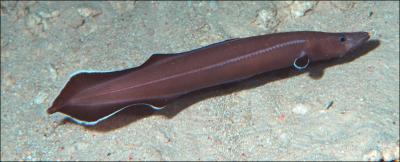Science News
New Eels are Living Fossils
August 17, 2011

The description “living fossil” may sound derogatory, but to an eel recently discovered off the Pacific island nation of Palau, it’s actually quite a compliment.
Discovery News defines “living fossil” as a term coined by Charles Darwin.
These are extremely long-lasting species that have undergone few bodily changes over the millennia.
Protoanguilla palau certainly qualifies—as a newly-described eel species belonging to a new genus and family, with quite a long history.
The team of researchers dates its evolutionary history back 200 million years!
Many of the physical features of this “new” eel reflect its relationship to the 19 families of Anguiliformes, representing 800 species of true eels currently living. Other, more primitive physical traits, such as a second upper jaw bone and a vertebrae count less than 90, have only been found in fossil forms from the Cretaceous period. Still other traits, such as a full set of bony- toothed “rakers” in the gill arches, are a common feature in most bony fishes, but lacking in both fossil and living eels.
The eel’s odd looks even confused the experts, reports Discovery News.
“The eel looks so bizarre—large head with relatively short body and various unique, internal characters—that no ichthyologist, including us, correctly identified it as a member of true eel at first sight,” co-author Masaki Miya [said].
(Check out a video of the creature at Wired.)
Beyond the physical features, the team’s analyses of total mitochondrial DNA indicate that P. palau represents an ancient, independent lineage with an evolutionary history comparable to that of the entire order of living and fossil eel species.
The Academy’s own John McCosker is quoted in Discovery News about the find and the science behind it.
The analysis they have performed using morphology and genetics is brilliant and invites as many questions about eel evolution as it solves.
The living fossil eels were found in a cave in shallow water off one of the Pacific islands in the Republic of Palau, but the researchers hope to discover more in deeper water. In addition, the researchers hope that such a treasure brings awareness to the marine biological diversity in the area.
“The discovery of this extraordinary and beautiful new species of eel underscores how much more there is to learn about our planet,” lead author Dave Johnson said. “Furthermore, it brings home the critical importance of future conservation efforts—currently this species is known from only 10 specimens collected from a single cave in Palau.”
Image: Jiro Sakaue